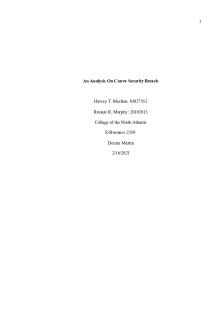Canva Study Guide: Expectations Violation Theory PDF

| Title | Canva Study Guide: Expectations Violation Theory |
|---|---|
| Course | Critical Approaches to Communication |
| Institution | Maryville University |
| Pages | 4 |
| File Size | 322.3 KB |
| File Type | |
| Total Downloads | 32 |
| Total Views | 137 |
Summary
Canva Study Guide: Expectations Violation Theory...
Description
This theory falls under the phenomenological communicator section of Craig's table. The phenomenological communicator is concerned with human connection and dialogue.
The Expectation Violation Theory explains how human behaviors and communication styles make us feel differently about one another-- it attempts to explain comfort in conversation and the outcome of conversations because of the comfortability level
The Expectation Violations Theory outlines how our experiences with others define the way we view them. Similarly, the phenomenological communicator wants to form relationships through communication and strong dialogue.
Arousal: a heightened state of awareness, orienting response, or mental alertness that stimulates a relationship
Communicator Reward Valence: The sum of positive and negative attributes brought to the encounter plus the potential to reward or punish in the future. Interaction Adaptation Theory: A systematic analysis of how people adjust their approach when another's behavior doesn't align with what's needed, anticipated, or preferred
Violation Valence: The perceived positive or negative value assigned to a breach of expectations, regardless of who the violator is.
Where do we see EVT? 1. Work-life: individuals might have a hard time communicating with one another and in turn, violate another's personal space, or expectations of the conversation because of the miscommunication.
3. Roommate Relationships: We might expect something from someone in terms of openness in communication about different aspects of living together that can potentially be violated by different living styles
2. Personal Romantic Relationships: Two individuals in a relationship that have different communication styles can experience a violation of expectation when their needs are not met through one another's behaviors.
I find this theory interesting because it explains the significance of important relationships and how they can change simply based on communication styles and behaviors. I think it is something we understand briefly based on
experience, but the fact that EVT puts a label on this phenomenon is important.
Reciprocity: a strong human tendency to respond to another's action with similar behavior. Interaction Position: A person's initial stance toward an interaction as determined by a blend of personal requirements, expectations, and desires....
Similar Free PDFs

Atomic Theory - Study Guide
- 12 Pages

Expectations
- 2 Pages

Norm Violation Exercise-5
- 3 Pages

Qué es Canva-convertido
- 1 Pages

Great Expectations
- 82 Pages

Crear Infografias Con Canva
- 16 Pages

Sappho+Study+Guide - Study Guide
- 5 Pages

Study Guide - HR - Study Guide
- 17 Pages

Benign violation v4
- 7 Pages

Canva Security Breach
- 7 Pages

Great Expectations
- 5 Pages

Ntscc Inno Lab - used canva
- 7 Pages
Popular Institutions
- Tinajero National High School - Annex
- Politeknik Caltex Riau
- Yokohama City University
- SGT University
- University of Al-Qadisiyah
- Divine Word College of Vigan
- Techniek College Rotterdam
- Universidade de Santiago
- Universiti Teknologi MARA Cawangan Johor Kampus Pasir Gudang
- Poltekkes Kemenkes Yogyakarta
- Baguio City National High School
- Colegio san marcos
- preparatoria uno
- Centro de Bachillerato Tecnológico Industrial y de Servicios No. 107
- Dalian Maritime University
- Quang Trung Secondary School
- Colegio Tecnológico en Informática
- Corporación Regional de Educación Superior
- Grupo CEDVA
- Dar Al Uloom University
- Centro de Estudios Preuniversitarios de la Universidad Nacional de Ingeniería
- 上智大学
- Aakash International School, Nuna Majara
- San Felipe Neri Catholic School
- Kang Chiao International School - New Taipei City
- Misamis Occidental National High School
- Institución Educativa Escuela Normal Juan Ladrilleros
- Kolehiyo ng Pantukan
- Batanes State College
- Instituto Continental
- Sekolah Menengah Kejuruan Kesehatan Kaltara (Tarakan)
- Colegio de La Inmaculada Concepcion - Cebu



